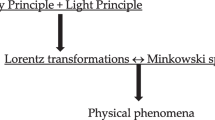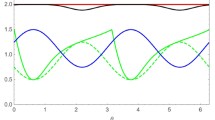Abstract
We may try to discuss gently the fact of “symmetric measurements outcomes” that is free from the order of measurements themselves, which fact might be extended to considering naturally the uncertainty principle. For two symmetric measurement outcomes, sometimes, the two measured observables are commutative. In this specific and symmetric example, we introduce a supposition that the operation Addition is equivalent to the operation Multiplication, and then, we may be apt to have an example of an inconsistency, probably due to the nature of Matrix theory based on non-commutativeness. We show here the inconsistency in an arbitrary dimensional unitary space when measuring commuting observables/an observable. We would say that the trial above might be categorized into an inconsistency example in the effect of the uncertainty principle, if we are forgiven for describing the above.
Similar content being viewed by others
Data availability
No data associated in the manuscript.
References
Sakurai, J.J.: Modern Quantum Mechanics. Addison-Wesley Publishing Company, New York (1995)
Peres, A.: Quantum Theory: Concepts and Methods. Kluwer Academic, Dordrecht (1993)
Redhead, M.: Incompleteness, Nonlocality, and Realism. Clarendon Press, Oxford (1989)
von Neumann, J.: Mathematical Foundations of Quantum Mechanics. Princeton University Press, Princeton, New Jersey (1955)
Nielsen, M.A., Chuang, I.L.: Quantum Computation and Quantum Information. Cambridge University Press, Cambridge (2000)
Holevo, A.S.: Quantum Systems, Channels, Information, A Mathematical Introduction (De Gruyter, 2012). https://doi.org/10.1515/9783110273403
Nagata, K., Diep, D.N., Farouk, A., Nakamura, T.: Simplified Quantum Computing with Applications. IOP Publishing, Bristol (2022). https://doi.org/10.1088/978-0-7503-4700-6
Heisenberg, W.: Uber den anschaulichen Inhalt der quantentheoretischen Kinematik und Mechanik. Zeitschrift für Physik (in German) 43(3–4), 172–198 (1927)
Kennard, E.H.: Zur Quantenmechanik einfacher Bewegungstypen. Zeitschrift für Physik (in German) 44(4–5), 326 (1927)
Weyl, H.: Gruppentheorie und Quantenmechanik. Hirzel, Leipzig (1928)
Nagata, K., Nakamura, T.: Violation of Heisenberg’s uncertainty principle. Open Access Library Journal, 2(8), e1797/1–6 (2015). https://doi.org/10.4236/oalib.1101797
Nagata, K.: There is no axiomatic system for the quantum theory. Int. J. Theor. Phys. 48, 3532 (2009). https://doi.org/10.1007/s10773-009-0158-z
Nagata, K., Nakamura, T.: Can von Neumann’s theory meet the Deutsch-Jozsa algorithm? Int. J. Theor. Phys. 49, 162 (2010). https://doi.org/10.1007/s10773-009-0189-5
de Barros, J.A.: Comments on: There is no axiomatic system for the quantum theory. Int. J. Theor. Phys. 50, 1828 (2011). https://doi.org/10.1007/s10773-011-0696-z
Hofer, W.A.: Heisenberg, uncertainty, and the scanning tunneling microscope. Front. Phys. 7, 218 (2012). https://doi.org/10.1007/s11467-012-0246-z
We cannot introduce a supposition that the sum rule is equivalent to the product rule if \(A_1\) and \(A_2\) are not commutative. Therefore, \([A_1,A_2]= 0\) is an important sufficient condition for our interesting objective
Avron, A., Zamansky, A.: Non-deterministic semantics for logical systems. In: Gabbay, D., Guenthner, F. (eds) Handbook of Philosophical Logic. Handbook of Philosophical Logic, vol 16. Springer, Dordrecht (2011). https://doi.org/10.1007/978-94-007-0479-4_4
Acknowledgements
We thank Soliman Abdalla, Jaewook Ahn, Josep Batle, Mark Behzad Doost, Ahmed Farouk, Han Geurdes, Preston Guynn, Shahrokh Heidari, Wenliang Jin, Hamed Daei Kasmaei, Janusz Milek, Mosayeb Naseri, Santanu Kumar Patro, Germano Resconi, and Renata Wong for their valuable support.
Funding
Not applicable.
Author information
Authors and Affiliations
Contributions
KN, DND, and TN wrote and read the manuscript
Corresponding author
Ethics declarations
Ethical approval
The authors are in an applicable thought to ethical approval.
Competing interests
The authors state that there is no conflict of interest.
Additional information
Publisher's Note
Springer Nature remains neutral with regard to jurisdictional claims in published maps and institutional affiliations.
Rights and permissions
Springer Nature or its licensor (e.g. a society or other partner) holds exclusive rights to this article under a publishing agreement with the author(s) or other rightsholder(s); author self-archiving of the accepted manuscript version of this article is solely governed by the terms of such publishing agreement and applicable law.
About this article
Cite this article
Nagata, K., Diep, D.N. & Nakamura, T. Two symmetric measurements may cause an unforeseen effect. Quantum Inf Process 22, 94 (2023). https://doi.org/10.1007/s11128-023-03841-5
Received:
Accepted:
Published:
DOI: https://doi.org/10.1007/s11128-023-03841-5




